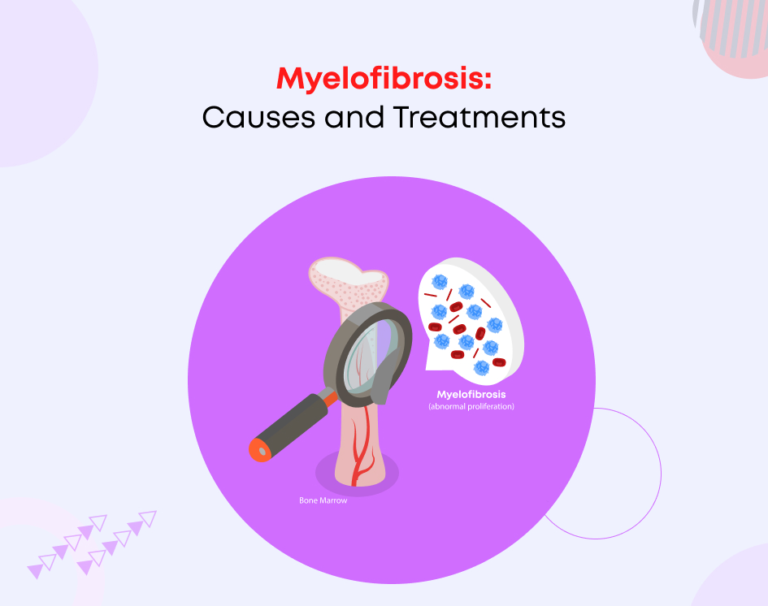
Myelofibrosis: Causes and Treatments
Myelofibrosis is a type of blood cancer impacting the bone marrow. Understanding this condition is crucial for early detection and effective management. In this article, we’ll explore the causes, symptoms, and treatment options for myelofibrosis. We will also learn about how it impacts individuals and the available avenues for support and care.
What is Myelofibrosis?
Myelofibrosis, also known as primary myelofibrosis, is a type of chronic blood cancer characterized by the abnormal development of bone marrow. In this condition, the bone marrow becomes scarred and fibrous, leading to disruption in the production of blood cells.
- Myelofibrosis originates from the malfunctioning of stem cells in the bone marrow.
- Over time, the bone marrow loses its ability to produce an adequate number of blood cells.
- The condition can occur spontaneously or as a progression from other myeloproliferative neoplasms (MPNs). For example, essential thrombocythemia or polycythemia vera.
- Myelofibrosis can affect individuals of any age. However, it is more common in older adults, with the average age of diagnosis being around 65 years old.
- While myelofibrosis is considered a rare disease, its prevalence may be underestimated due to misdiagnosis or underreporting.
Learning the basics of myelofibrosis sets the stage for exploring its causes and symptoms comprehensively.
Causes of Myelofibrosis
While the exact cause of myelofibrosis remains unclear, several factors contribute to its development. Knowing these underlying causes can aid in early detection and management of the condition. Here they are:
- Genetic Mutations
Certain genetic mutations, such as JAK2, CALR, and MPL mutations, are associated with the development of myelofibrosis.
- Bone Marrow Disorders
Pre-existing bone marrow disorders, such as polycythemia vera or essential thrombocythemia, can progress to myelofibrosis.
- Immune Dysregulation
Dysregulated immune responses, including aberrant T-cell activation and cytokine signalling, can also play a role in the pathogenesis of myelofibrosis.
- Epigenetic Modifications
Aberrant epigenetic changes involving DNA methylation and histone modifications contribute to the dysregulation of gene expression in myelofibrosis.
- Microenvironmental Factors
Alterations in the bone marrow microenvironment contribute to the development of fibrosis.
- Hematopoietic Stem Cell Niche Dysfunction
The dysfunction of the hematopoietic stem cell niche contributes to the pathogenesis of myelofibrosis. This comprises abnormal interactions between hematopoietic and stromal cells.
- Environmental Factors
Exposure to certain toxins or radiation may increase the risk of developing myelofibrosis.
Identifying potential causes enables healthcare providers to tailor treatment plans accordingly, addressing specific risk factors and underlying conditions.
Symptoms of Myelofibrosis
Recognizing the myelofibrosis symptoms is crucial for early diagnosis and intervention. While the presentation of symptoms may vary among individuals, certain common signs indicate the presence of this condition.
- Anaemia-related
Fatigue, weakness, and shortness of breath are common symptoms associated with anemia in myelofibrosis.
- Portal Hypertension
Enlarged spleen (splenomegaly), abdominal pain or discomfort, early satiety, and portal hypertension-related complications such as ascites and varices.
- Constitutional
Fever, night sweats, and unintended weight loss may occur due to the inflammatory nature of myelofibrosis.
- Bone-related
Bone pain, especially in long bones, ribs, and spine, may result from fibrotic tissue expanding in the bone marrow.
- Thrombocytopenia-related
Easy bruising, bleeding gums, petechiae, and prolonged bleeding from minor injuries may occur due to decreased platelet counts.
Identifying these primary myelofibrosis symptoms prompts further evaluation and diagnostic testing, facilitating timely intervention.
Signs that Myelofibrosis is Progressing
Monitoring the progression of myelofibrosis is essential for optimizing treatment strategies and managing complications effectively. Certain signs that myelofibrosis is progressing, warranting close medical supervision and intervention, are:
- Transformation to Acute Leukemia
Progression to acute myeloid leukaemia (AML) or blast-phase myelofibrosis is a sign of advanced disease and carries a poor prognosis.
- Increased Splenic Size
Progressive enlargement of the spleen (splenomegaly) despite treatment may indicate worsening fibrosis and disease progression.
- Cytogenetic Abnormalities
The development of additional cytogenetic abnormalities, such as complex karyotype or high-risk mutations, may signify disease progression and treatment resistance.
- Decline in Performance Status
Deterioration in functional status may indicate advanced disease and poor prognosis. This deterioration is characterized by decreased performance status or worsening Eastern Cooperative Oncology Group (ECOG) score.
- Development of Thrombotic Complications
Progressive thrombocytopenia and thrombotic events, like deep vein thrombosis (DVT) or pulmonary embolism (PE), may occur as the disease advances.
Regular follow-up appointments and monitoring help healthcare providers assess disease progression and adjust treatment plans accordingly.
Treatment Options for Myelofibrosis
Managing blood cancer myelofibrosis involves a multidisciplinary approach tailored to individual needs and disease severity, which are:
- Medications
Pharmacological interventions, including JAK inhibitors, immunomodulatory agents, and chemotherapy, help suppress abnormal cell growth and alleviate symptoms.
- Blood Transfusions
Transfusion of red blood cells or platelets may be necessary to manage anemia and thrombocytopenia associated with myelofibrosis.
- Stem Cell Transplant
An allogeneic stem cell transplant is also known as a bone marrow transplant. It offers a potential cure for myelofibrosis by replacing diseased bone marrow with healthy donor cells.
- Novel Therapies
Emerging targeted therapies, such as telomerase inhibitors, hedgehog pathway inhibitors, and histone deacetylase (HDAC) inhibitors, are available. They offer promising options for patients with myelofibrosis.
- Immunotherapy
Immune checkpoint inhibitors and adoptive cell therapy are being investigated as potential immunotherapeutic approaches for myelofibrosis.
- Radiation Therapy
Palliative radiation therapy may be used to alleviate symptomatic splenomegaly or bone pain in patients with myelofibrosis.
- Experimental Treatments
Participation in clinical trials evaluating novel agents and treatment combinations provides access to cutting-edge therapies. Along with that, it contributes to the advancement of myelofibrosis treatment.
Collaboration between patients, caregivers, and healthcare providers is essential in navigating treatment decisions and optimizing outcomes.
Final Thoughts
Knowing the causes, symptoms, and treatment options for MPN myelofibrosis is paramount for individuals affected by this rare blood cancer. By shedding light on myelofibrosis and its complexities, we can foster greater understanding and support for those impacted by this condition. Thus, everyone should raise awareness and promote a collaborative approach to care. Doing this can empower individuals with myelofibrosis to navigate their journey with resilience and hope.








